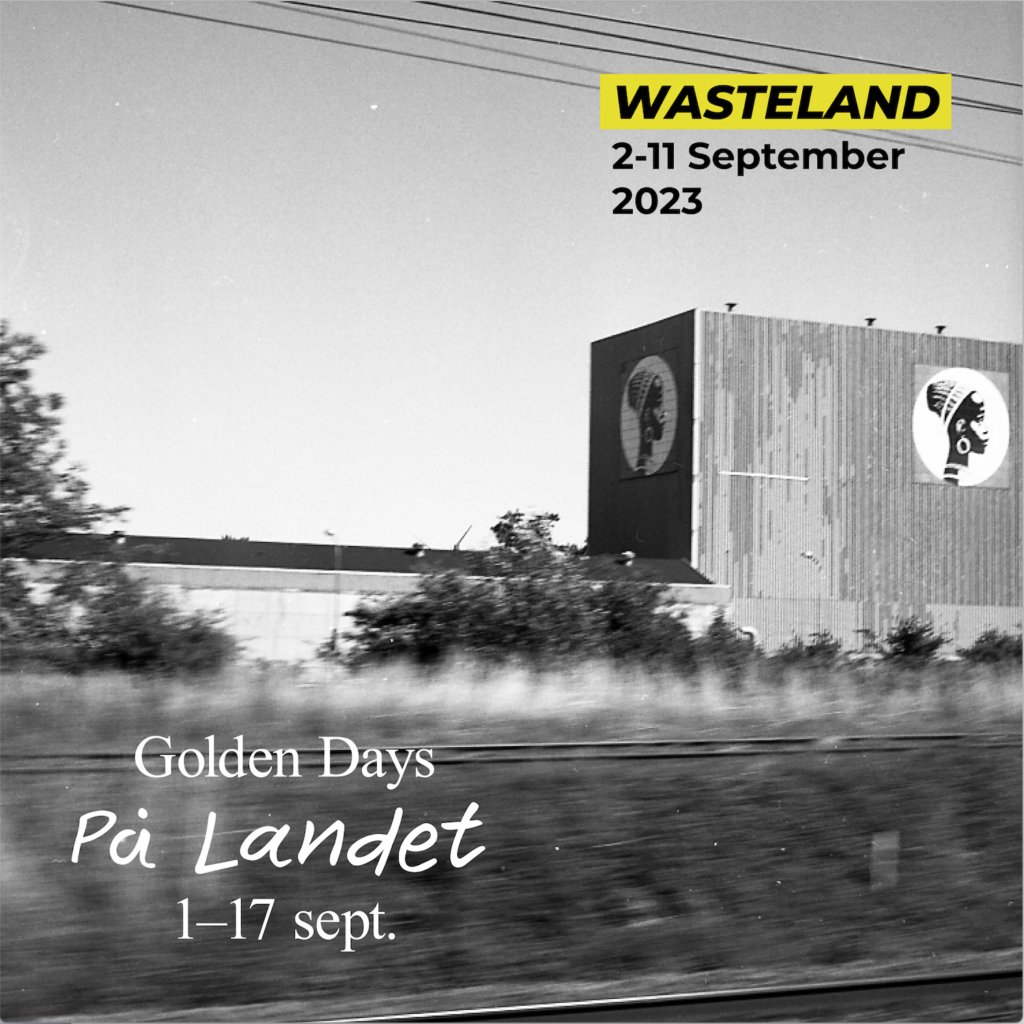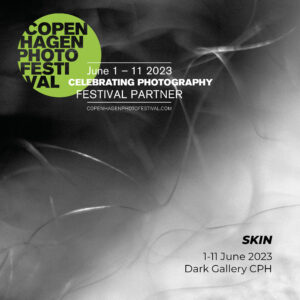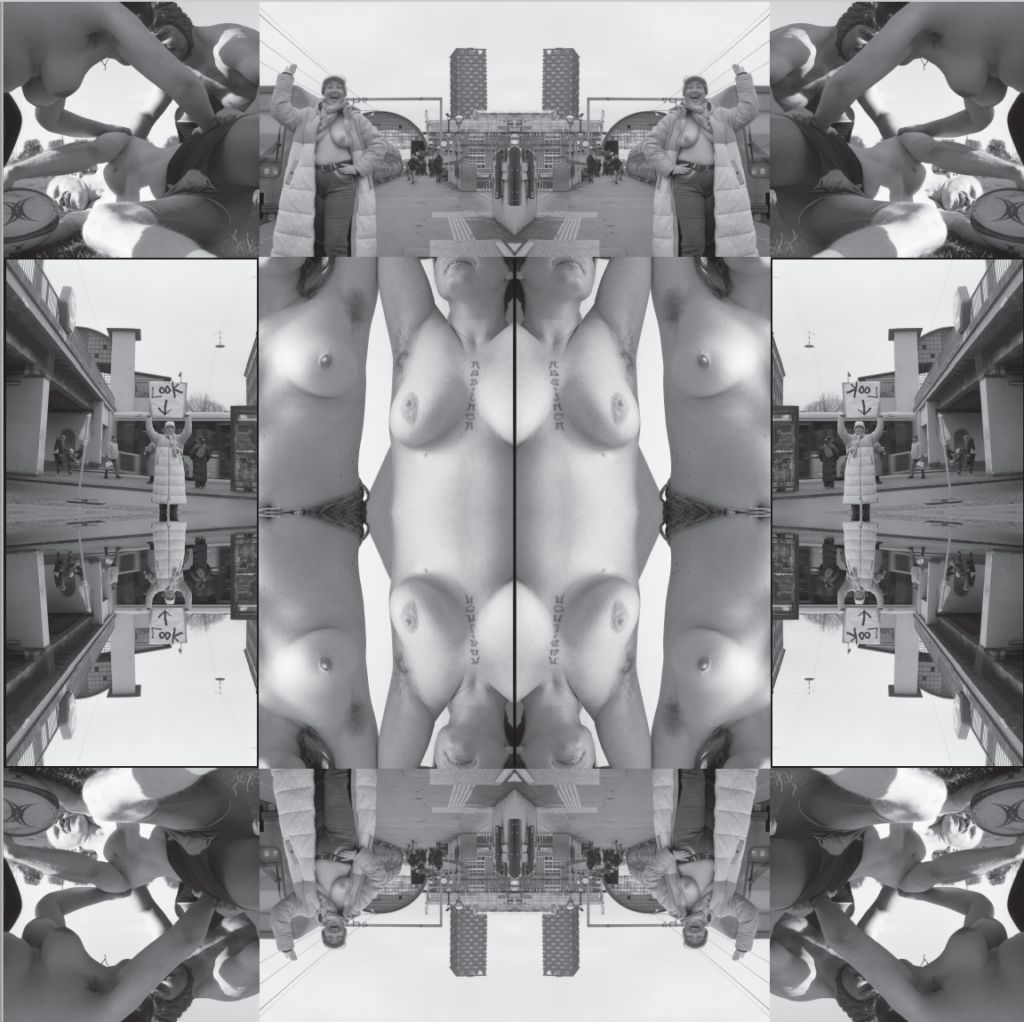
NYC Street Level – A Photographic Retrospective of New York City in the 1980s and 90s
Photographic Exhibition and Multimedia Installation
Rolando Diaz
8-17 November 2024
Eye-witness photography by American-Colombian Rolando Diaz, who worked New York’s streets, hottest nightclubs, and fashion runways as a photographer in the 1980s and ‘90s. His lens captured the soul of the city during the birth of hip-hop, the rise of counterculture and clubbing, and the devastating impact of the AIDS epidemic.
“NYC Street Level” is the first retrospective of his New York photography from the 1980s and 90s, offering a captivating glimpse into this dynamic period of creative expression. The exhibition coincides with the release of his photography book, also titled “NYC Street Level,” featuring a curated selection of images from the exhibition.
NYC in the dark
In the Dark Spaces, visitors are invited to explore the tiled bathroom, discovering a photo series captured by Rolando Diaz in such legendary nightclubs as Pyramid and Area famous for their graffiti-covered tiled walls. Seated on the bathroom toilet, visitors can listen to a soundscape with stories from New York’s iconic nightclubs of the time – and even add their own graffiti tags to the walls.
The gallery’s rear Dark Space houses a powerful multimedia installation that evokes the raw energy of 1980s and 90s New York. Through a projected photo series, viewers are immersed in a city grappling with change, where street art thrives, communities resist gentrification, and the AIDS epidemic casts a long shadow.
In the gallery’s naturally lit, street-facing space, Rolando Diaz presents a series of evocative B&W and colour prints, offering intimate glimpses into his fashion photography, personal life, and the dynamic energy of New York City’s street life.
About the artist
Before settling in New York in 1983, Rolando Diaz studied audio-visual communication in Rome, Italy. In addition to his New York career as a photographer for the Italian fashion industry magazine Fashion, Rolando Diaz also worked a freelance professionally and as a photo printer at Chroma Copy of America. He moved to Denmark with his Danish wife and settled in Copenhagen in 1996, where he established DIAZ STUDIO in 2004.
Rolando Diaz has an extensive career as a photographer, which in addition to editorial photography for fashion publications also includes portraiture, street photography and photography for musicians. His works were exhibited in the 1990s in galleries in New York, London Madrid and many other cities. In Copenhagen, he has exhibited at the Round Tower. Rolando Diaz is also master of analogue photographic processes and alternative printing techniques.
Throughout the exhibition, gallery visitors can meet the artist and purchase signed copies of the “NYC Street Level” photography book. Limited-edition, museum-quality prints will also be available for acquisition.
Rolando Diaz will join Dark Gallery CPH as a full partner on 1 January 2025.
Learn more about the artist here: www.diazstudio.dk
@diazstudio.cph
Exhibition period
8-17 November 2024
Thursday and Friday 13:00-17:00
Saturday and Sunday 13:00-16:00
Opening reception /Vernissage
Thursday, 7 November, 16:30-19:00
Meet the artist
Gallery visitors can meet Rolando Diaz during opening hours.
Admission to Dark Gallery CPH is always free.
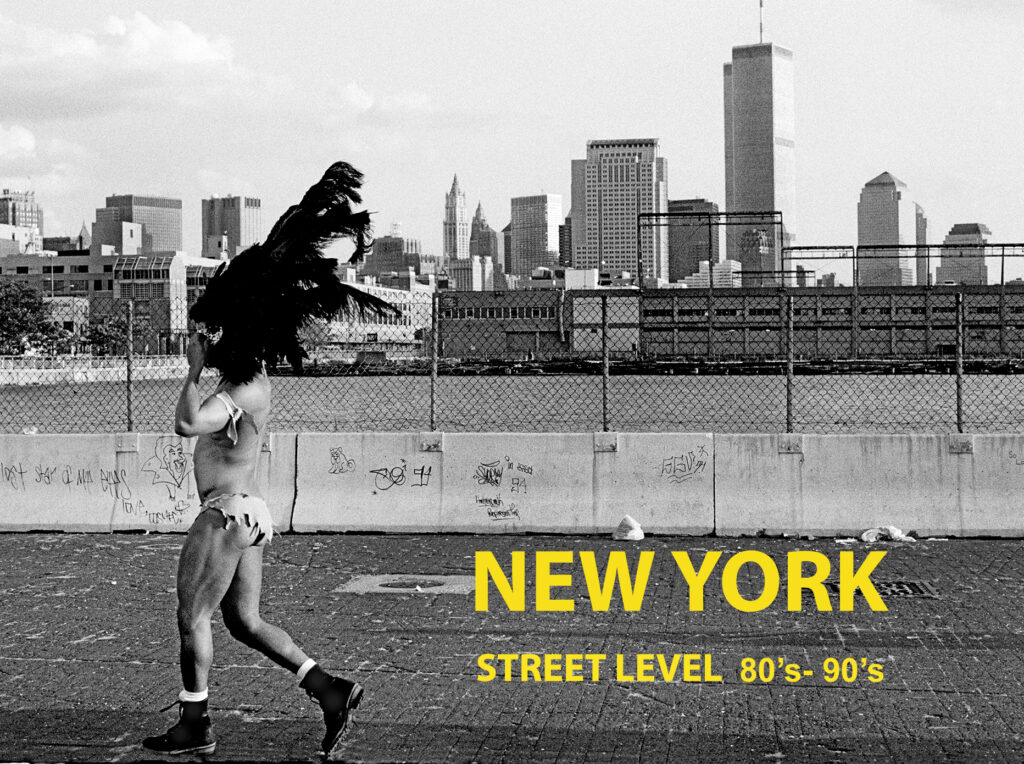
Previous exhibitions:

Songs for the River // Canciones para el río
“Songs for the River // Canciones para el río” by art photographer Kristina Aurora is a poetic tribute to Colombia’s Atrato River, ravaged by illegal gold mining and mercury poisoning. With 85% of the country’s gold mined illegally, Colombia ranks among the world’s worst for mercury pollution. This crisis affects both local communities and global ecosystems, as mercury spreads through rainfall into the oceans.
The artist’s poetic-meditative exhibition at Dark Gallery CPH seeks to offer a space for reflection, where visitors are invited to pause, listen, and empathise with our shared responsibilities.
Kristina Aurora travelled to Columbia in 2023 with her vintage Hasselblad camera to document the impact of illegal gold mining. Her darkroom colour prints are featured in the daylit front gallery. Additionally, visitors venturing into the Dark Spaces will encounter a mine-like environment illuminated solely by headlamps. Here, they will discover a collage series of analogue photos, where chemical processes and metals amplify the juxtaposition of natural beauty and destruction. Notably, the metal gallium is applied to some images, creating the illusion of solidified mercury.
Within the Dark Spaces, a sound installation weaves together field recordings from Colombia with excerpts of Afro-Colombian spiritual songs known as “alabaos.” Traditionally sung a cappella, these melancholic songs express mourning and guide the deceased to paradise. In this space, the artist goes beyond merely presenting a crisis; she invites us to linger and experience the river’s song – haunting, tender, and urgent all at once. Through this immersive experience, she aims to awaken in us a sense of care for the delicate balance between human ambition and the natural world.
“Amidst this devastating environmental crisis, I aim to artistically reclaim the innocence and beauty that the river and its natural treasures once embodied. Those of us living outside Colombia need an emotional connection and space for reflection to truly grasp that this crisis affects us all and necessitates action, even here in Europe. The constant barrage of news and photo documentaries about global crises can overwhelm us, leaving us feeling helpless. That’s why I strive for a poetic and meditative engagement through my Colombian photo series, hoping it fosters a deeper sense of shared responsibility,” says Kristina Aurora.
Exhibition period: 3-26 October 2024
Thursday + Friday + Saturday 12:00-16:00
Free admission
Vernissage: Thursday 3 October at 16:30-19:00
Meet the artist
Meet Kristina Aurora in the gallery during opening hours on the following days: 3., 4., 11, 12, 18 and 19 October.
Limited-editing darkroom prints and collages are available for purchase directly from the artist.
Read more about the artist here.
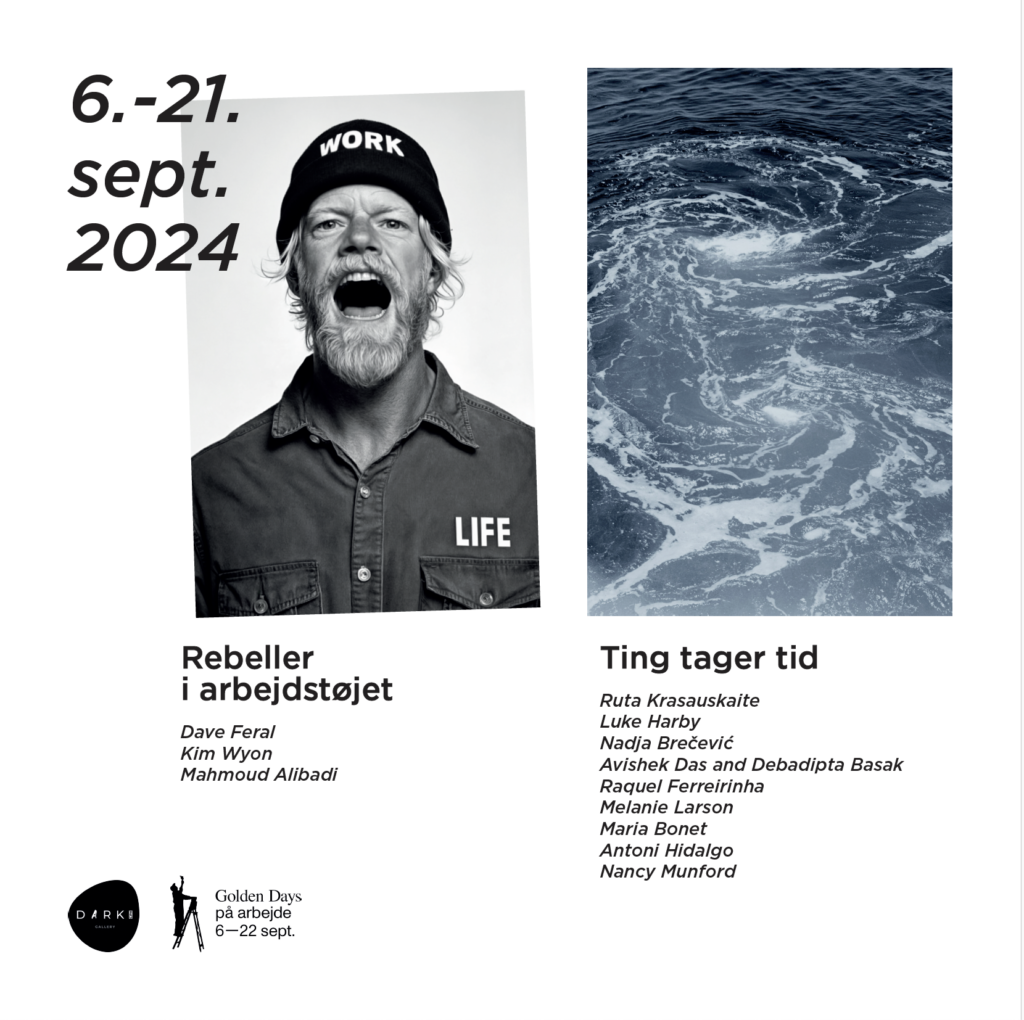
Golden Days på arbejde
Dark Gallery CPH spotlights our work life in three exhibitions to coincide with the Golden Days på arbejde festival.
The gallery exhibitions are open from 6-21 September 2024, between 12.00 and 16.00 every day of the week.
Under the collective title “Rebeller i arbejdstøjet” (Rebels Geared Up for Work), two interactive installations, both driven by artificial intelligence, will be featured in the gallery’s Dark Spaces.
The daylit front gallery will additionally host the group exhibition “Things Take Time,” where nine international artists explore the concept of time through their analogue photography.
Read more about the exhibitions below.
Dark Spaces:
The Life and Death of John Doe
The multimedia installation, “The Life and Death of John Doe,” created by German artist Dave Feral, offers a critical examination of work-life balance. Using analogue cassette tape decks as your guide, you’ll trace the fictional work hero’s journey from conformity to self-awareness and ultimately rebellion. The narrative and visuals of this exhibition are entirely generated by artificial intelligence.
Visitors navigate the darkened exhibition space using a headlamp. Their feedback on their own work lives is registered on an online “Happiness Map” either by live interview at the gallery or by completing the questionnaire here.
The Rebel Fridge
The gallery’s newest exhibition space for micro-projects is an illuminated refrigerator located in the pitch-black bathroom. In an installation by artists Kim Wyon and Alibadi, visitors are invited to rearrange cans labelled with the names of public figures who, according to artificial intelligence, are the best examples of contemporary rebels.
Each day, the movement of the 30 cans within the fridge is recorded in a logbook kept in the freezer compartment. This allows for insights into who the audience perceives as genuine rebels throughout the exhibition’s duration — and who they consider to be mere pretenders, capitalising on rebellion for personal gain.
Visitors are also encouraged to suggest names of true rebels in the visitor guestbook. These suggestions will become part of the later second iteration of The Rebel Fridge.
Read more about The Fridge on our dedicated Micro-Projects webpage.
Front gallery:
Things Take Time
“Things Take Time” is a group exhibition exploring the multifaceted nature of time through analogue photography.
The nine contributing artists use unique analogue photography techniques — often a time-consuming process — that add depth and complicate the linear conceptualisation of time which prevails in our society.
Beyond the rigid structure of clock time, the artworks highlight periods of absence, cyclical patterns, and the power of the present moment, emphasising the importance of ‘the process.’
Curated by US artist Maria Heines @maria.heines, the exhibition is the result of an open call.
Contributing artists:
Antoni Hidalgo (Spain) @inercies_
Avishek Das and Debadipta Basak (India) @and_analogphotography
Luke Harby (UK) @lukeharby
Maria Bonet (Belarus) @maria_elena_bonet
Melanie Larson (Denmark) @mela_kunst
Nadja Brečević (Sweden) @nadjabrecevic
Nancy Munford (US) @theunsteadyproject
Raquel Ferreirinha (Portugal) @stillstoriesbyraquel
Ruta Krasauskaite (Lithuania) @rutakras

Blind Dates
12-16 June 2024
“Blind Dates” explores entanglement, fragility, and hope
Two complete strangers were brought together in a makeshift studio, tasked with painting each other’s skin opposing colours. This act aimed to equalise and unite them, creating a shared social space.
The project took a dramatic turn as life mirrored art. Artist Mahmoud Alibadi, severely injured before the shoot, co-directed the session via video link. The female model, A.K., arrived with bruises from a recent emergency hospitalisation. These unexpected brushes with mortality added a poignant layer. How did these experiences influence the Blind Date – and the resulting photographs?
Filmmaker Ryder Pomerleau captured the awkward expectations of the “Blind Dates” project, driving from England in his car to document the Copenhagen shoot. His film will be a central part of the exhibition.
All exhibition images are darkroom contact sheets. The undoctored images were taken using an analogue Hasselblad 500 by art photographer Kim Wyon. This raw, authentic presentation further underscores the project’s themes of vulnerability and connection.
Visitors to the gallery can meet the artists and contributors on all days of the exhibition. For the opening reception, visitors are encouraged to bring a blind date – or get ready for one!
Art photographer: Kim Wyon
Visual artist: Mahmoud Alibadi
Filmmaker: Ryder Pomerleau
Models: A.K. and Jerry Nortey
Opening reception
Wednesday 12 June 16:00-19:00
Bring your blind date – or get ready for one!
Regular opening hours
Wednesday 12 June – Friday 15 June: 11:00 – 16:30
Saturday 16 June: 11:00 – 16:30
Partnered with Copenhagen Photo Festival
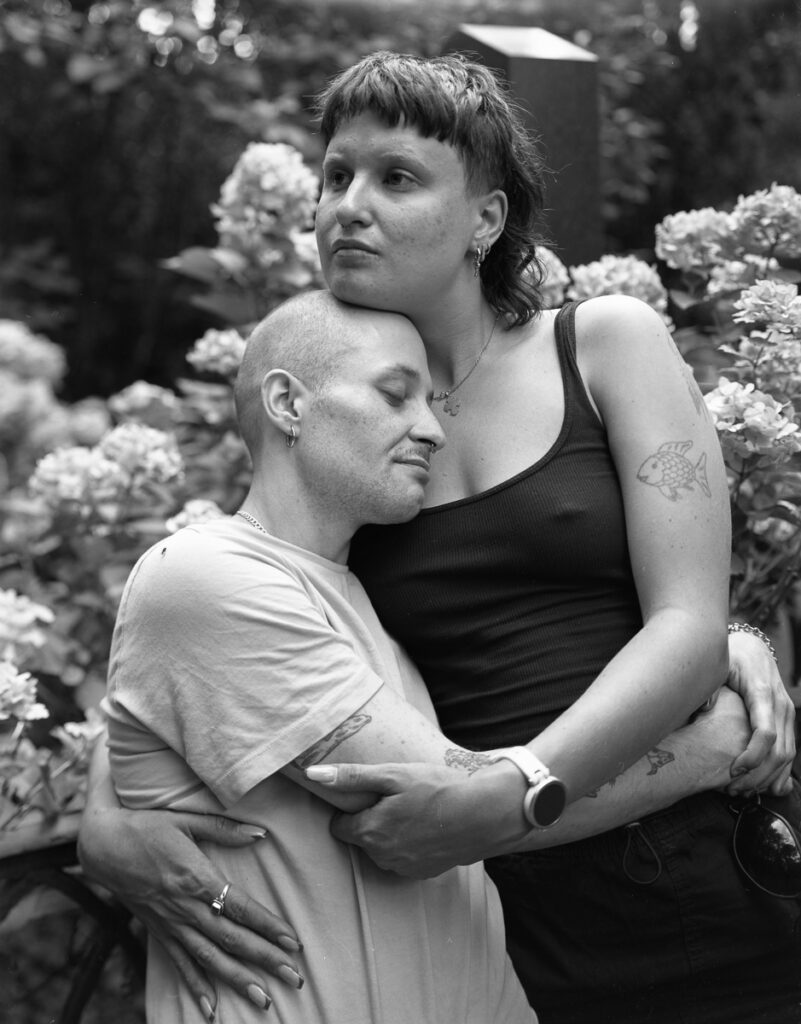
Heterotopia: The Living Souls of Assistens Cemetery
Photo Exhibition by George Doumani
4 May -1 June 2024
George Doumani’s “Heterotopia” offers a compelling exploration of analogue portraiture’s enduring power. His large-format photographs of Assistens Cemetery in Copenhagen transcend documentary, revealing a complex interplay of life and mortality with stunning detail and tonal depth.
For the past two years, Australian photographer George Doumani has explored Assistens Cemetery at all hours, armed with his large-format analogue camera. His captivating portrait series captures the essence of those who find moments of life within this place of rest.
A unique process
Large-format cameras have recently undergone a revival. These cameras use oversized film negatives and a bellows mechanism to focus light. Photographers favour them for their exceptional image detail, precise focus control, and ability to manipulate perspective. Their continued use speaks to the pursuit of exceptional image quality and unique artistic expression.
“I chose a large-format camera for its deliberate process, which creates a unique dynamic with my subjects. The tripod, the focusing cloth…it sparks curiosity and connection. But it’s time-consuming, requiring subjects to remain perfectly still during the long exposure,” says George Doumani.
Where time stands still
The exhibition title, “Heterotopia,” references French philosopher Michel Foucault’s concept of separate spaces that exist within society yet operate under different rules. Cemeteries, with their stark contrast to the living world, embody this idea.
Doumani’s portraits reveal the diverse ways people interact with the cemetery – couples cooling down after a concert, dog walkers, even those on their first date.
“I find the ways people use Assistens Cemetery fascinating,” Doumani explains. “It’s a sanctuary, yet a place where we confront the mortality we all fear. It’s a paradox: people seek life and intimacy within the very walls that surround death.”
The unique atmosphere of George Doumani’s photographs stems from his meticulous technique. The images evoke a sense of timelessness, even though the subjects are clearly straight off the streets of contemporary Copenhagen. His portraits immortalise these ‘living souls,’ echoing how the cemetery’s tombstones preserve the memory of the departed. “The images are haunting, yet masterfully beautiful – timeless and lingering,” observes Kim Wyon of Dark Gallery CPH.
Meet the artist
The photographer will be present in the gallery on selected days during the exhibition where you can learn more about his project and experience his large-format camera and the sizeable negatives from the exhibition.
The artist will be present on 11, 17, 18, and 25 May.
Other opening days between 4 May – 1 June:
Thursdays + Fridays 12:00-16:00
Saturdays: 12:00-15:00
Always check our Google listing for updated opening hours
Gallery opening reception will be on 3 May from 17:00
The “Heterotopia” portrait series has not previously been exhibited. All exhibited images are inkjet prints. Contact George Doumani directly at elmegade3@gmail.com for inquiries on purchase of limited-edition prints.
—
With “Heterotopia,” Dark Gallery CPH returns to Assistens Cemetery for the third time, unearthing the sentiments of this unusual location.

Family Photos
Maria Heines
5-27 April 2024
Family Photos by Maria Heines inspects place, family dynamics, and the entangled nature of past and present.
Family Photos documents the artist’s time visiting family in America. Where she circled around family histories with her late grandfather’s old analogue camera, picking up pieces of the past found in the present. Searching for how previous constellations of abuse, neglect, and love materialise into current family dynamics.
During this process, the artist aims to ground herself in family history, but avoid fixing herself to a single narrative to die on a cross for. Visually she walks this fine line with repetition, clutter, empty space, barriers, and frozen moments to evoke both connection and disconnection within and between photographs. When reading these photographs empathy is of utmost importance.
All images in Family Photos are analogue darkroom prints.
Family Photos will be displayed at Dark Gallery CPH from 5-27 April 2024. The exhibition will evolve with revisions from the artist as she works in the gallery on the 5, 12 and 20 April. Visitors are welcome to join her on these days to learn more about her process and photographs.
Maria Heines is an American artist and researcher based in Copenhagen. In her photographic work, she is drawn to subtleties and details that shed light on the softer, more delicate aspects of life. While in her collaborative artistic research practice, she focuses on co-creating healthier and happier realities.
More on her work can be found at mariaheines.com
Exhibition opening days: 5, 6, 11, 12, 13, 18, 19, 20, 25, 26, 27 April
Check our Google Listing and Facebooks event for updated opening hours.
There is always free admission to Dark Gallery CPH.

Korean Babel
An interactive, mobile-enabled photo exhibition and AI laboratory on the poetry, madness and dynamic autonomy of translations of Korean street signage generated by artificial intelligence.
Exhibition period: 1 Feb – 24 March 2024
What happens when you use mobile-enabled translation to read Korean street signage? Photographer Kim Wyon spent a week in September 2023 exploring the street signage in the print shop district of Seoul and the markets of Busan in South Korea armed with his analogue Hasselblad camera, a pile of Kodak film rolls – and his mobile phone.
“If you’ve ever tried using your mobile phone to translate Asian street signs, you’ve probably wondered how reliable the results are. The translation is often erratic madness – but also pure poetry. This exhibition showcases black-and-white collages of Korean street signage, representing a form of stream-of-conscious poetry born from a dynamic dialogue with artificial intelligence,” explains photographer Kim Wyon.
AI laboratory
As part of the Korean Babel exhibition, an AI laboratory will be installed in the gallery’s Dark Spaces where visitors use mobile phone apps to study how visual interference can impact AI-generated translation. The AI-laboratory will highlight how artificial intelligence processes information – and why it sometimes misinterprets the signage and context entirely. Before entering the Dark Spaces, visitors will be handed a headlamp, which will be their only light source apart from the glare of their mobile phone. The AI laboratory has been developed by AI architect Jon Hindsgaul Hansen in association with photographer Kim Wyon. Graphic design is by Raffaele Cavaiolo.
“Why does ChatGPT hallucinate and offer erratic translations? And how does artificial intelligence recognise Korean text among shadows and other visual obstructions? These are some of the phenomena that visitors can explore in the AI lab using their mobile phone,” explains AI architect Jon Hindsgaul Hansen.
The exhibition is open from 1 February to 24 March 2024.
See current opening hours on our Facebook event post and on Google.
Any changes to opening hours will be listed on Google.
The exhibition is also open by appointment. Contact the gallery.
Vernissage: Saturday 3 February at 13:00-16:00.

You read the photo-poems by Kim Wyon using translation apps on your mobile phone.
![]()
![]()
Previous exhibitions:

SUPERPOWER
Ghosts of the Atomic Age
Exhibition period: 29 Sep – 25 Nov 2023
Is our advanced technology beyond our control? A photo-documentary exhibition of Europe’s decommissioned Nuclear Power Stations by Ukraine photographer Oleksandr Martemianov.
A trained photographer and engineer, Oleksandr Martemianov has travelled across Europe over the past 4 years to capture images of decommissioned nuclear power plants. With his large-format analogue camera, he has documented 23 nuclear power plants in Europe. Having grown up near Chornobyl in Ukraine, and later relocated close to the Barsebäck Nuclear Power Plant in Sweden, his inquest is fuelled by his personal story. At a time when new nuclear power plants are being planned in Europe and the pros and cons of advanced technologies, such as artificial intelligence, are hot topics, Oleksandr Martemianov poses the question: Can we, as a society, handle the complex nature of the technology we create?
SUPERPOWER invites gallery visitors to study imagery from decommissioned nuclear power plants across Europe. They will also be able to explore Soviet-era military maps of Europe’s nuclear power plants – in the flickering flashlight of their own mobile phone. On selected days, visitors can meet Oleksandr Martemianov in person. On 5 Nov from 15:00-17:30, a public talk will additionally be held at the gallery where the photographer will engage in dialogue with physicist Jon Hindshaul Hansen.
About the exhibition
SUPERPOWER marks the first public showing of Oleksandr Martemianov’s photo-documentary project, which includes imagery from visits to 23 decommissioned nuclear power plants in Europe, many of which are off-limits to the press and public. On occasion, Oleksandr Martemianov had to deliberately point his camera in the opposite direction of the power plants so not to arouse local suspicion.
Oleksandr Martemianov’s project has included desktop research. He has also met with some of the surprisingly few people tasked with guarding Europe’s disused nuclear power plants. The premise of his investigation has been to maintain an open mind regarding the pros and cons of nuclear power, while mapping the fluid political landscapes and public perceptions that have shaped the nuclear power industry.
SUPERPOWER is presented in all three gallery spaces, two of which are Dark Spaces, where the lighting is intended to be a performative part of the exhibition concepts. In the last Dark Space, visitors will be invited to explore Soviet-era maps of Europe’s nuclear power plants – in the flickering flash light of their own mobile phones. This section of the exhibition will focus on the connection between the civilian and military use of nuclear power in both Western and Eastern Europe. The examples include the Krümmel Nuclear Power Plant in Schleswig-Holstein, Germany, where an increase in cases of leukaemia was detected in the vicinity before the plant was closed in 2011, and the Zaporizhzhia Nuclear Power Plant in Ukraine, which has recently suffered military attack by Russian occupation forces.
Nuclear power plants that Oleksandr Martemianov has visited and photographed:
- Brokdorf (KBR). Schleswig-Holstein, Germany
- Ågesta (R3/Adam). Stockholms län, Sweden
- Krümmel (KKK). Schleswig-Holstein, Germany
- Stade (KKS). Lower Saxony, Germany
- Unterweser (KKU). Lower Saxony, Germany
- Barsebäck. Skåne län, Sweden
- Brunsbüttel (KKB). Schleswig-Holstein, Germany
- Oskarshamn. Kalmar län, Sweden
- Greifswald (KKW). Mecklenburg-Vorpommern, Germany
- Philippsburg (KKP). Baden-Württemberg, Germany
- Obrigheim (KWO). Baden-Württemberg, Germany
- Mühleberg (KKM). Canton of Bern, Switzerland
- Lucens (VAKL). Canton of Vaud, Switzerland
- Fessenheim. Grand Est, France
- Superphénix (SPX). Auvergne-Rhône-Alpes, France
- Phénix. Occitania, France
- Biblis (KWB). Hesse, Germany
- Würgassen (KWW). North Rhine-Westphalia, Germany
- Kahl (VAK). Bavaria, Germany
- THTR-300. North Rhine-Westphalia, Germany
- Mülheim-Kärlich (KMK). Rhineland-Palatinate, Germany
- Grohnde (KWG). Lower Saxony, Germany
- Helmholtz-Zentrum Hereon (former GKSS). Schleswig-Holstein, Germany
About the photographer
Oleksandr Martemianov grew up 200 km from the Chernobyl Nuclear Power Plant in Ukraine. He was born in 1990, four years after the catastrophic reactor meltdown at the plant, which caused extensive radiation contamination. In 2016, Oleksandr moved to Sweden and settled only 15 km from the now closed Barsebäck Nuclear Power Plant. Oleksandr Martemianov is a trained photographer and mechanical engineer.
Quote
“On my first visit to the Barsebäck Nuclear Power Plant, two fighter jets blasted across the sky as I approached, as if warning me off. I could almost see the pilots in action. Although I knew this was a coincidence, this experience came to foreshadow just how difficult it often is to engage with the custodians of these phantoms of the atomic age – and get them to talk. Much of my investigation into nuclear power has simply been driven by an urge to learn more. Although I grew up close to Chornobyl during a time when nuclear power was increasingly seen as a threat, I’ve sought to keep an open mind about both the pros and cons of the technology. As an engineer, I am perhaps less afraid of technology in general. However, I find the politics and vested interests that surround this field of technology the most disturbing aspect of all. You need to ask yourself if we, as a society, indeed can handle such complex technologies.”
Opening hours:
Opening hours: Thu-Fri 12:00-17:30
Saturday 11:00-15:30
Meet-the-artist days: 20 + 21 October during opening hours.
Talk: 5 Nov. 15:00-17:30
Admission to Dark Gallery CPH is free.
WASTELAND
Wasteland is an analogue photography exhibition that explores the borderland between our urban and rural realms – and nature’s revenge. We asked 5 photographers to capture the useless, wasted and divinely forsaken.
Wasteland is part of the Golden Days Festival – Golden Days på Landet @golden.days
Opening days: 2-11 September 2023 from 12:00-16:00
Vernisage: 2 September at 12:00 noon
Contributing photographers:
Kristina Aurora Simonsen
@kristina.aurora.photography
Maria Heines
Carl Magnus Lindström
@carlmagnuslinstrom
Jón Bjarni Hjartarson
@jon_bjarni
Kim Wyon
@dark_gallery_cph
The exhibition also includes Dias film projections in the gallery Dark Spaces by @andreas_olesen
SKIN
Intimacy in an age of alienation
The SKIN exhibition at Dark Gallery CPH combines analogue print photography and slide projections contributed by two artists and one activist artist collective. Each contributor has explored the concept of intimacy against the backlight of our times of alienation.
Erika Matsunami
Berlin-based Japanese visual artist Erika Matsunami (photography, video, installation and performance) invites us into a world of close-up photography where the body is remapped and reshaped by the ontological preconceptions and expectations of the viewer. Inspired by post-war phenomenology, her alienated motifs depict undisclosed skin and body parts that beckon our sensual and emotional interpretation. Erika Matsunami’s micro-lens inspired exploration of human skin is conveyed as slide projections into the gallery’s Dark Space 1, which is a fully functional bathroom. The front gallery exhibits 3 B&W silver gelatine prints and 4 coloured C-prints by the artist – images that are part of her investigative project B.O.D.Y. the second skin. The context of her photography and artistic oeuvre is communicated via a poem that is also available in braille, 4 dialogue postcards, and a QR code to her website. The imagery by Erika Matsunami will be on display at Dark Gallery CPH until September 2023.
Read more about Erika Matsunami here.
Andreas Olesen
Danish-American artist photographer Andreas Olesen has created a mechanical projection installation with a complex motion drive for a diapositive film loop. Designed using 3D printed spools, a modified vintage slide projector and ball bearings from skateboards, his prototype projection installation invites visitors to explore several generations worth of images, all compiled in random order. The images are both personal and anonymous, vernacular and specific, historical and contemporary, and are picked from the archives of three generations of two lines of his family as well as his own collection of found images. Among them, images of his gun-slinging (Danish) grandmother and his dope-smoking teenage years alongside colonialist images from Greenland. The projection installation materialises the social media exposure of the digital age to create a kind of “mechanical Instagram.” Qualified by a true-to-life sense of immediacy and intimacy, the projection installation and its unfiltered imagery offers both conceptual and emotional respite from our alienated world of online pretence. Much to the artist’s surprise, the film loop is flipped mirror-opposite with each rotation. A mathematical formula for this inversion is yet to be explored. Technical production by Sean Mitchel and Luke Boshoff. Andreas Olesen’s projection prototype will be on display in Dark Space 2 at Dark Gallery CPH until October 2023.
Read more about Andreas Olesen here.
The Missing Alliance
A pop-up exhibition by the activist feminist group the Missing Alliance offers a sneak-peek of their joint exhibition to be featured at Dark Gallery CPH in October 2023. The Missing Alliance explores how the female body remains estranged from the public space, which in a roundabout way renders unwarranted intimacy to what rightfully should be a normalised sphere of commonality. The activists pose incisive questions, such as why women do not have the same freedom as men to walk bare-chested in public, why they are expected to shave their body hair and wear makeup, and why women’s menstrual fluid is considered an embarrassment. Seeking to explore the female body liberated from the sexualised male gaze, the activists engage in street happenings and feminist activism in the public space, which is documented in the pop-up exhibition in the form of 4 kaleidoscopic B&W photo collages.
Images by the Missing Alliance
“Because A Mother Never Stops Bleeding”
Dark Gallery CPH is excited to invite to the opening of photographer Carolina Echeverri’s art show and publication release, entitled:
“Because A Mother Never Stops Bleeding”

The show centers around Echeverri’s delicate yet radical publication, which explores the biological and psychological changes brought about by motherhood. The diary-turned-activism piece aims to shed light on the lack of research and awareness around the invisible cost of motherhood. It is a collection of personal reflections, intimate photography, mother’s testimonies, women’s brains, and neuroscience woven together to give greater meaning to the maternal struggle.
Through the publication and art show, Carolina seeks to confront the lack of understanding and awareness around the mental changes brought about by motherhood. The show features a collection of images that blend maternal life with the beauty of biology. The luscious brain landscapes serve as a background to her maternal candid yet anxious view, and are based on scientific brain images created from MRI projections, brain slices, and histology imagery from different human, mostly female, subjects.
According to Carolina, this project was born out of a personal realisation of the biological and psychological changes brought about by motherhood. In the absence of sufficient research and education, she turned to personal research to understand these changes better, which led to the creation of this publication.
“This is not a science book or exhibition,” Carolina emphasizes, “it’s a personal diary which mutated into printed activism through research and passion.” The publication is a manifestation of her heart-breaking rebellion against ongoing structural systems that fail families with their most basic humanity all around the globe.
Exhibition period: 6-27 May 2023
Opening: 4 May from 15:00-17:00
Opening days:
Tuesdays and Wednesday 14:00-17:00
Thursdays and Fridays 14:00-18:00 (except 18-19 May)
Saturdays 11:00-15:00 (except 20 May)
The gallery is also open by appointment.
Read more about photographer Carolina Echeverri here: www.carolinaecheverri.com
For further information please contact:
Press: Viktoria Skovhus – T: +4540768492 – vskovhus@gmail.com
2 September 2022 – 1 May 2023
I have a crown, I am a queen
What makes you an everyday queen? We posted an open call on social media looking for co-interpreting female models. Six women approached the gallery to share their life, dreams and ideas with us. Exploring the uncharted borderland between social-media selfie and photographer-guided portraiture, we created individual kaleidoscopic storyboards that reflected on the co-creative process and dialogue.
The exhibition was featured in the gallery dark space in the red glow of darkroom safety lighting. Visitors could experience how the artificial light in the adjacent rooms naturally changed colour after the visit to the dark space – because their eyes had gotten used to the red background light of the dark space. Some suddenly saw the light as green, others yellow or beige – even though the light sources had not changed.
The exhibition was developed in partnership between photographer and artist Kim Wyon from Dark Gallery CPH and artist Mahmoud Alibadi.
The exhibition at DARK GALLERY CPH was part of the Golden Days Festival 2022 and remained open from 2 September until 28 October 2022.

11 March – 20 May 2022
MAKING THE INVISIBLE VISIBLE – Travel into dreams
Travel into dreams – in the gallery darkroom. War nightmares, romantic fantasies, otherworldly escapes?
Recently graduated as a photographer from Universitè Paris 8, Vincennes Saint-Denis, in Paris, Cléa Castel invites visitors to explore nightly dreams in the gallery dark space. Bring your friends, lie down on the soft matrasses and cushions, close your eyes, listen to stories of dreams – and share your own. Or visit alone and whisper your nightly dreams to complete strangers.
You can book a private dream-sharing session on Tuesdays 15:00-16:00 for you and your friends – or join a group of strangers.
On Monday 14 March, you can join evening dream-sharing from 19:00-21:00.
Cléa Castel’s dream photography series will also be featured on the walls of the dark spaces in DARK GALLERY CPH. Get accustomed to the red safetylight of the darkroom and pick them out.
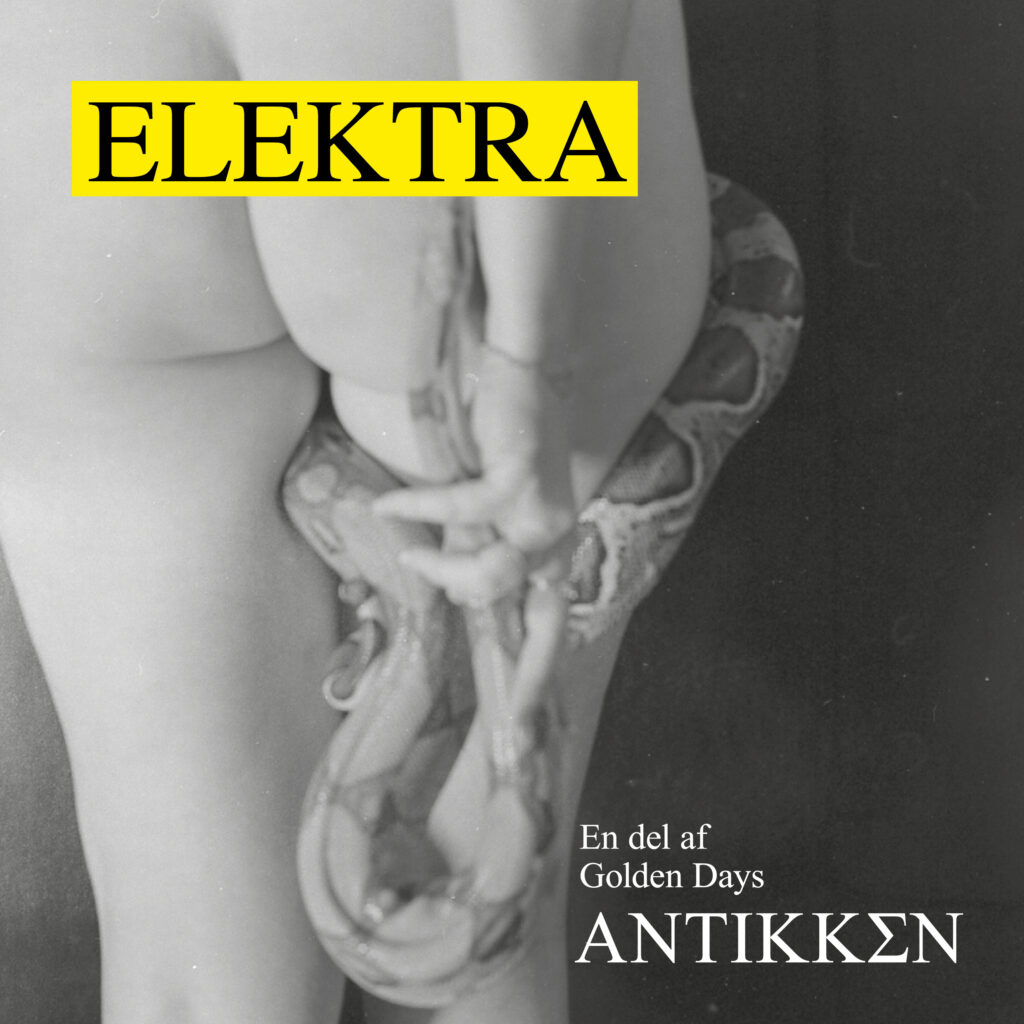
4 September 2021 – 1 February 2022
NARCISSUS – og de syge myter / MYTHS BY MATCH LIGHT
Analogue photography by match light. The exhibition took a
dark look at the ancie
Analogue photography by match light. The exhibition took a dark look at the ancient Greek myths that have given rise to modern-day psychiatric diagnosis. Visitors were handed a box of matches at the entrance with which to explore the analogue kaleidoscopic collages that were featured in the gallery dark space.
Visitors would explore the multi-layered collages by flickering match light, an experience enhanced by the slight wind current of a small fan in the gallery space. During opening days with many visitors, the sulphuric odour of the many match strikes would create an atmosphere reminiscent of the grottos of the Oracle of Delphi.
The classic Greek myths of Antiquity are the founding narratives of modern-day psychiatric diagnosis. They are tales of phobia, traumas and madness. In the Greek myths, these states of mind were often seen to be induced by the gods. The exhibition sought to mirror these ancient tales of madness in our panicked age of pandemic and power-grabbing narcissism.
During the pandemic lockdown, the exhibition was open by appointment to closed groups, including school classes.
The exhibition was concepted and created by photographer and artist Kim Wyon. The exhibition at DARK GALLERY CPH was part of the Golden Days Festival, ANTIKKEN.

MAU MAU – the exhibition has been prolonged until 1 January 2023
MAU MAU is a documentary photo exhibition based on a never-before published war diary and photo album of a British soldier serving in colonial Kenya in 1955.
For decades, coffee-growing European settlers, including Danish storyteller Karen Blixen, had colonised the ancestral lands of the Kikuyu tribespeople in the Kenyan highlands. When MAU MAU insurgents rebelled against the colonists in the 1950s, the Kikuyu suffered the worst British war crime against civilians since the RAF bombing of Dresden in World War II.
More than 1.5 million Kikuyu were deported by the colonists to a system of concentration camps where they suffered starvation, torture, rape, summary execution, forced labour, and rampant epidemics.
The MAU MAU exhibition is a personal journey of discovery by a son of the British soldier – in search of answers to questions never asked.


